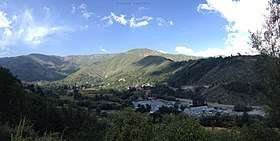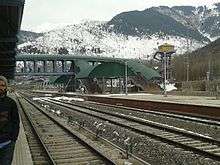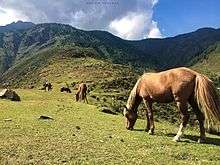Banihal
| Banihal | |
|---|---|
| City of Mountains | |
 Banihal Pass (pic: Shoaib Tantray) | |
 Banihal Location in Jammu and Kashmir, India  Banihal Banihal (India) | |
| Coordinates: 33°25′N 75°12′E / 33.42°N 75.2°ECoordinates: 33°25′N 75°12′E / 33.42°N 75.2°E | |
| Country | India |
| State | Jammu and Kashmir |
| District | Ramban |
| Elevation | 1,647 m (5,404 ft) |
| Population (2011) | |
| • Total | 3,900 |
| Languages | |
| Time zone | UTC+5:30 (IST) |
| Pincode | 182146 |
| Vehicle registration | JK19 |
| Website | http://ramban.gov.in |
Banihal "City of Mountains" is a town also known as "Gateway of Kashmir" and a notified area committee in Ramban district in the Indian state of Jammu and Kashmir. It is a rural and a hilly area with Kamirwah being one of the most spectacular hills. It is located about 35 km (22 mi) away from Qazigund of Anantnag district on NH 44 (former name NH 1A before renumbering of all national highways). However, the distance between Banihal and Qazigund is only 18 km by train on the new railway line which is much shorter than the road. The most common language spoken in the region is Kashmiri; Urdu and English being other familiar languages.
Etymology
"Banihal" means blizzard in Kashmiri language. Another view regarding the origin of the name of the place is that the word 'Banihal' has actually been derived from two Kashmiri words viz 'bah' meaning twelve and 'nallhe' meaning a rivulet. Twelve rivulets signifying the various brooks flowing through the area and eventually joining the small local river called Nalla Bischlari. There is a yet another school of thought amongst the locals and some scholars in which the word banihal is thought of as having a Persian origin. "Nihal" in Persian means greenery and hence Banihal would imply 'Eternally green'.
In some older texts it has also been referred to as 'Devgol' (The abode of mystical giants).
Banihal Pass
Banihal Pass At 2,832 m (9,291 ft) elevation, the Pir Panjal mountains connect Banihal with Qazigund on the other side of the mountains. The Pir Panjal mountain range separates the Kashmir valley in the Indian state Jammu and Kashmir from the outer Himalaya and plains to the south. After closure of the Murree-Muzaffarabad-Srinagar road on partition of India in 1947, Banihal pass was the only passage from Jammu to Srinagar after independence until 1956 when Jawahar Tunnel was bored through the Pir Panjal range. The pass is accessible only in summer and in winters also if there is no heavysnowfall... IF there is heavy snowfall during winters the roads are closed for few days until the snow is cleared from highway
Banihal Road Tunnels
Existing road tunnel
A 2.5 km (1.6 mi) long tunnel at elevation of 2,194 m (7,198 ft) through Pir Panjal mountain under the Banihal pass connects Banihal with Qazigund on the other side of the mountain. The tunnel named Jawahar tunnel after the first Prime Minister of India was constructed in early 1950s and commissioned in December 1956 to ensure snow-free passage throughout the year. However, it remains closed for a few weeks in winter due to snow avalanches. It was designed for 150 vehicles per day in either direction but now used by more than 7,000 vehicles per day in both directions.[1] Therefore, a new wider and longer tunnel has been planned at a lower elevation.
Jawahar tunnel is maintained by Border Road Organisation (BRO) of the Indian army and guarded 24x7 by the CRPF (Central Reserve Police Force), which also monitors it by CCTVs as the tunnel is vital for the Kashmir valley. The tunnel used to be closed to civilian traffic from midnight to 08:00 until 2009. Now it is open 24 hours a day.
New double road tunnel
Construction of a new 8.45 km (5.25 mi) long Banihal Qazigund Road Tunnel started in 2011 to widen NH 44 (former name NH 1A before renumbering of all national highways) to four lanes. It is a double tube tunnel consisting of two parallel tunnels - one for each direction of travel. Each tunnel is 7 metre wide tunnel and has two lanes of road. The two tunnels are interconnected by a passage every 500 metres for maintenance and emergency evacuation. The tunnel will have forced ventilation for extracting smoke and stale air and infusing fresh air. It will have state of the art monitoring and control systems for security.
The new tunnel's average elevation at 1,790 m is 400 m lower than the existing Jawahar tunnel's elevation and would reduce the road distance between Banihal and Qazigund by 30 km. The new tunnel would also be less prone to snow avalanche as it will be at a lower elevation. The vehicles will have to pay toll tax to use the tunnel. The Southern portal (end) of the tunnel is at 33°29′22″N 75°10′22″E / 33.4895°N 75.1729°E and the Northern portal (end) of the tunnel is at 33°33′53″N 75°11′12″E / 33.5646°N 75.1867°E.
As of May 2016, 7.2 km of the 8.5 km had been excavated.[2] Boring of the entire 8.5 km tunnel was completed on 20 May 2018[3] and the tunnel may open in 2019.
Banihal Rail Tunnel
A new 11.215 km (7 mile) long Banihal-Qazigund tunnel (also known as Pir Panjal railway tunnel) for the Jammu–Baramulla line connecting Bichleri Valley of Banihal with Qazigund area of Kashmir Valley has been constructed. The tunnel is 8.40 m wide with a height of 7.39 m. There is a three metre wide road along the length of the tunnel for the maintenance of railway tracks and emergency relief. The boring was completed in October 2011, its lining and laying of rail tracks was completed in the next one year and trial run commenced at the end of 2012. Commercial runs started from 27 June 2013 reducing the distance between Quazigund and Banihal by 17 km (from 35 km by road to 17.5 km by train).[4]
The tunnel’s average elevation at 1,760 m (5,770 ft) is 440 m (1,440 ft) below the existing road tunnel.[5] The rail tunnel will facilitate transportation during winters when inclement weather forces closure of the road tunnel and Srinagar-Jammu highway. Pir Panjal Railway Tunnel is India's longest and Asia's third longest railway tunnel (28 km long Taihang Tunnel in China is the longest and 21 km long Wushaoling Tunnel in Gansu, China is the second longest).
The north portal of the Banihal railway tunnel is at 33°33′42″N 75°11′56″E / 33.5617942°N 75.1988626°E and the south portal is at 33°27′48″N 75°11′38″E / 33.463203°N 75.193992°E.
Banihal railway station

Banihal railway station is situated at 1,702 m (5,584 ft) above mean sea level. It was commissioned on 26 June 2013 and passenger trains run from Banihal to Qazigund. The railway network in Kashmir from Banihal to Baramulla is now 137 km. Five trains run daily from Banihal to Baramulla. Until the 148 km Katra-Banihal section of Jammu–Baramulla line gets constructed, expected to be completed by 2018, people can travel from Jammu Tawi or Udhampur to Banihal by road and take the train from Banihal to Srinagar.
Demographics
As of 2011 India census,[6] Banihal had a population of 3,900 of which 2,453 (57%) are males while 1,447 (43%) are females. Banihal has an average literacy rate of 68%, higher than the Indian national average of 59.5%; with 66% of the males and 34% of females literate. 12% of the population is under 6 years of age. Population of children with age of 0-6 is 388 which is 9.95% of total population. In Banihal Municipal Committee, Female Sex Ratio is of 590 against state average of 889. Moreover, Child Sex Ratio in Banihal is around 902 compared to Jammu and Kashmir state average of 862. Literacy rate of Banihal city is 83.77% higher than state average of 67.16%. In Banihal, Male literacy is around 91.33% while female literacy rate is 70.31%.
Banihal town has 645 houses and is divided into seven electoral wards.
Historical references
According to the Rajatarangini (C-1000-1011 AD) – a chronicle that recorded the history of Kashmir and its Kingdoms and Kings, Banihal was known as ‘Vishalta’ in the 11th Century and was a very narrow mountain valley which was used as an escape route by revolting Princes, rebel Chieftains, and even conspirators from Kashmir. In the 11th Century, a small fort called ‘Bansalla’ also existed below the old Banihal Pass. The Bansalla Fort belonged to the 11th Century ruler of Vishalta the Khasa Lord Bhagika who was the son-in-law of the Lord of Buddha Tikka. Pandit Sahib Ram, who in his book “Tirthas” copies Abu'l-Fazl ibn Mubarak's notes, metamorphosizes the Sanskrit name of village Banihal from Bhanusita or Bhanusata, i.e., rocks of the Sun or land of the Sun. Aurel Stein on his commentary on Kalhana's Rajatarangini describes the place differently. According to him, Visalata or Banihal must be identified with the valley drained by rivulet Bischlari.
Gallery


 The local Rivulet Bischlari
The local Rivulet Bischlari
See also
References
- ↑ http://mod.nic.in/Samachar/mar5/html/army.htm
- ↑ http://www.governancenow.com/news/regular-story/tunnels-hope-in-valley
- ↑ http://www.kashmirtimes.in/newsdet.aspx?q=79343
- ↑ http://indiatoday.intoday.in/story/indian-railways-pir-panjal-tunnel-kashmir-valley-asia-second-longest-tunnel/1/239901.html
- ↑ http://usbrl.org/aboutus.php
- ↑ "Census of India 2001: Data from the 2001 Census, including cities, villages and towns (Provisional)". Census Commission of India. Archived from the original on 2004-06-16. Retrieved 2008-11-01.